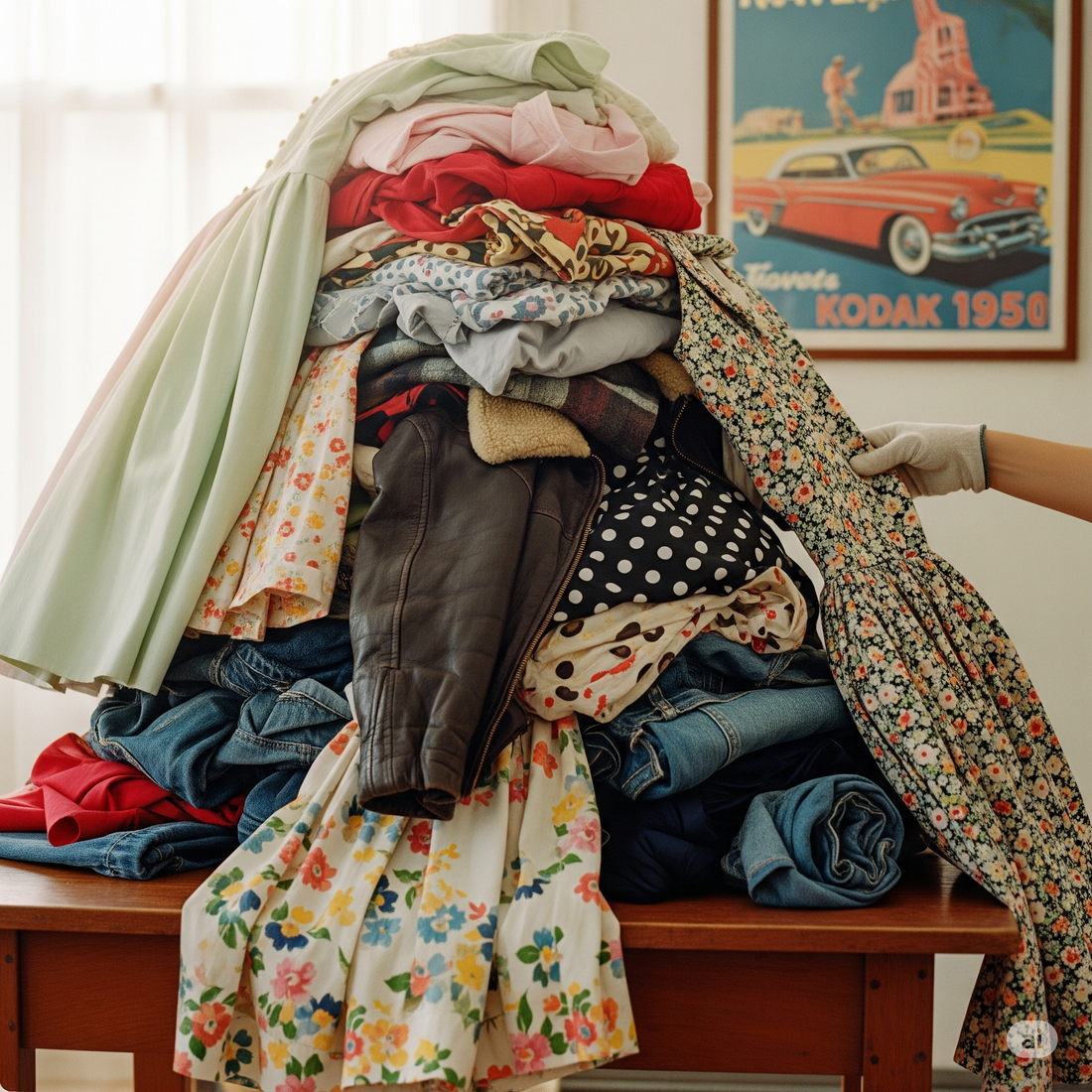
Cleaning and Caring For Your Vintage Treasures
Share
Caring for and cleaning vintage clothing requires thoughtful, gentle methods to preserve these delicate, often fragile pieces that carry historical and aesthetic value.
Here are expert tips to help you maintain your vintage wardrobe:
1. Gentle Hand-Washing Over Machine Washing
Avoid using a washing machine, which can cause agitation, fading, tearing, or damage to delicate trims and fabrics. Instead, hand wash your vintage garments carefully in lukewarm or cool water with a mild detergent formulated for delicate fabrics, such as Ivory Snow or wool shampoo. Gently massage the fabric between your fingertips without rubbing harshly. Rinse thoroughly until all soap is removed.
2. Spot Cleaning When Possible
If the garment is not visibly dirty or odorous, avoid full washing. Spot-clean stains with a soft cloth dampened with water and a small amount of mild detergent, testing on an inconspicuous area first to prevent color loss or fabric damage. This method reduces stress on the fabric and prolongs garment life.
3. Special Care for Fragile Fabrics
Silk and wool need extra attention. For silk, soak in cool water with mild soap, add a small amount of white vinegar to the rinse water to restore luster, then rinse well and lay flat to dry. Avoid exposure to direct sunlight, which fades colors and weakens fibers. Wool garments should be hand washed in cool water and dried flat to maintain shape and prevent shrinking.
4. Dry Cleaning Select Garments
Delicate and structured vintage pieces such as coats, evening wear, velvet, and heavily beaded items often benefit from professional dry cleaning—preferably with a cleaner experienced in vintage garments. Avoid standard dry cleaners unfamiliar with vintage textiles to prevent damage.
5. Proper Storage
Store vintage clothes in a cool, dry, and dark environment away from sunlight to prevent fading and fabric deterioration. Use padded hangers for dresses and blouses, and fold heavy knits with acid-free tissue paper to prevent creases and stretching. Avoid plastic covers that trap moisture; opt for breathable cotton or muslin garment bags instead. To deter pests, use natural options like cedar blocks or lavender sachets rather than mothballs that leave strong odors.
6. Regular Maintenance
Inspect garments regularly for loose buttons, frayed hems, or small tears, and repair these promptly to avoid worsening damage. When trying on vintage clothes, handle gently to avoid stressing weakened fibers and embellishments.
7. Additional Tips and DIY Remedies
For tough stains, a gentle homemade paste of dish soap and baking soda applied carefully can be effective. You can freshen fabrics with a light spray of a mixture of distilled water and inexpensive vodka, allowing the garment to air dry. When washing, always support the garment fully to avoid strain on seams and fabric.
Odor Control for Vintage Clothing
Controlling and removing odors from vintage clothing is a common challenge, often due to age, storage history, and previous environments. There are multiple effective and gentle methods to freshen vintage garments while protecting delicate fabrics.
Key Methods for Odor Removal
1. Vinegar
Bowl Method: Hang the garment above a bowl of white vinegar in a small, closed space (such as a closet) for a night or two. Ensure the fabric does not touch the vinegar directly. Afterward, air out the clothing to remove any lingering vinegar scent.
Spray Method: Lightly spritz distilled white vinegar directly on the garment, especially in musty spots. Let the item air dry in a well-ventilated area.
2. Baking Soda
Place the clothing item in a large bag or sealed container with dry baking soda. Let it sit for 24–48 hours, allowing the baking soda to absorb odors. Shake off or gently vacuum the residue afterward.
For spot deodorizing, sprinkle baking soda directly onto the garment, let it rest, and then brush off.
3. Vodka
Fill a spray bottle with undiluted cheap vodka (avoid flavored varieties), and spritz on the vintage clothing. The alcohol breaks down odor molecules, and as it evaporates, it carries odors with it. This method is especially popular for musty or smoky smells.
4. Activated Charcoal or Kitty Litter
Place the garment with activated charcoal or odor-absorbing kitty litter (in a separate bag or container) for a few days. Do not allow charcoal to touch the fabric, as it may cause staining. These substances can absorb persistent odors such as mothballs or mildew.
5. Sun and Air
Hang clothing outside in indirect sunlight on a breezy day. Fresh air and UV rays help break down odor molecules, but avoid direct sunlight for prolonged periods to prevent fading delicate fabrics.
6. No-Rinse Cleaners & Essential Oils
Use a no-rinse wool or delicate wash (like Eucalan) either as a wash or as a spray for garments that cannot be fully immersed. Some people also add a few drops of essential oil (e.g., rosemary, lavender) to unscented detergent for a subtle, fresh scent.
7. Other Remedies
Newspaper: Stuff newspaper into sleeves and pockets, place in a sealed bag for a couple of days to absorb odors.
Ozone Treatment: For persistent odors (like smoke), specialty cleaners may offer ozone treatment, which uses oxidizing gases to break down odors, though this is a professional service best suited for deeply embedded smells.
Ammonia: Diluted ammonia in a spray bottle can be effective, especially for very old odors, but use with adequate ventilation and caution, as it is harsher than other methods.
Considerations for Delicate or "Dry Clean Only" Items
Test any cleaning or deodorizing method on an inconspicuous area first.
For extremely fragile fabrics (such as some silks, beaded items, or 1930s and older pieces), consult a textile professional before applying any moisture or commercial cleaner. From personal experience, in my earlier years of curating vintage clothing I ruined a few pieces trying to DIY, and was heartbroken by the outcome. When in doubt, ask a professional.
By combining these careful cleaning and storage practices, you can ensure your vintage clothing remains vibrant and intact—preserving its charm and history for years to come.
